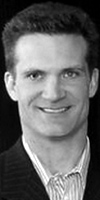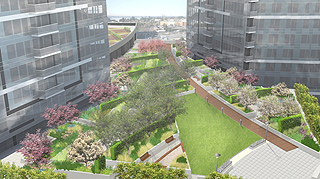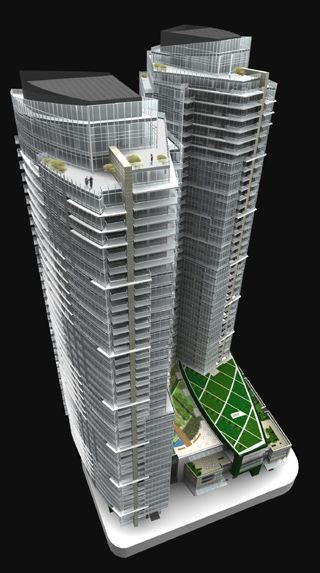
Surveys
DJC.COM
June 26, 2008
What lies ahead for sustainable design?
Gerding Edlen Development

Eaton
|
Bellevue will soon be home to an iconic building that will change the city forever. With two towers topping 40 stories each, Bellevue Towers will be the largest LEED gold residential development on the West Coast upon completion.
When I look at Bellevue Towers, however, I see it as a milestone for a slightly different, yet equally significant environmental reason: Not only will the residents of Bellevue Towers breathe life into the environment by preserving 125 to 150 acres that would have been needed to construct an equal number of single-family houses, but they will also be breathing life into the heart of the city’s urban core.
As important as the building is, it’s the residents who will push the sustainability envelope. The future residents of Bellevue Towers will initiate a cultural shift in the way we all think about living in this city. On average, each resident will reduce the time he or she spends in a car by at least 45 minutes a day. Residents will get more exercise, they’ll read more, and they’ll conveniently socialize when they wish.

Images courtesy of Gerding Edlen Development The green roof and 25,000-square-foot urban garden of Bellevue Towers will produce oxygen and insulate the building while using half the water of typical landscaping. |
It’s the social aspects of buildings such as these that will evoke a cultural change toward sustainability that really matters. The buildings we’re developing today are a 200-year asset, and the best way we can reduce the environmental footprint of the way we live is to design them in a way that attracts more residents and workers to the urban cores of our communities across the country.
Revolution is here
Gerding Edlen has pursued sustainable development for more than 10 years, resulting in 33 LEED projects. But what once was revolutionary is now becoming standard — and better. For instance, our first eco-roof, installed five years ago on the M Financial building in Portland, reduced rainwater runoff by 25 percent. Today, eco-roofs are sprouting on more and more buildings, and we’re seeing as high as a 40 percent runoff reduction.
Many of the other features pioneered on our early projects — displacement ventilation, photovoltaic panels, chilled beams, materials free of urea-formaldehyde and VOCs, dual-flush toilets — are starting to appear across the market.
At Gerding Edlen we believe that we need to go further and push on to the next level. LEED certification is still relatively new and there are just a handful of LEED-rated buildings, but we won’t just sit back and polish our certification plaques. Creating buildings that have smaller and smaller footprints and that are economically viable requires increased investment in new technologies and commitment from the marketplace, from public-private partnerships to business leadership to consumers.
On the technology front, we’re intrigued by the plasma arc generator, which uses extreme heat to transform waste into energy. It creates glass bricks that can be used in construction while treating sanitary waste so that none leaves the site. We’d love to see wind turbines successfully integrated into more buildings along with more photovoltaics. We know there’s a way to succeed. Our country, our states and our research centers must invest in bringing these ideas to fruition.

Bellevue Towers is expected to achieve LEED gold certification, a first among Washington residential projects. |
I think we’ll get to some of these advancements through the sheer force of the market. The Center for Health and Healing in Portland is a stellar example of that. Without Oregon Health Sciences University’s commitment, this building never would have achieved LEED platinum. Public institutions and private-sector businesses must be willing to take risks and explore new technologies that deliver terrific return on investment to both the bottom line, through long-term cost savings, and the environment.
Throughout our history, we’ve benefited from the support of government, clients and customers who believe in innovation, and our projects are the best proof — from condominiums to university buildings to medical centers. It’s been extremely gratifying to see how our partners have risen to the challenge. Believe me, you can’t build downtown Los Angeles’ first green, pedestrian-friendly neighborhood, which we’re doing at South Park, without some big vision.
Personal commitment
Consumers play a key role in market transformation as well. Portland’s emerging South Waterfront district is the largest sustainable urban redevelopment in the nation, and green is a key marketing feature. It’s working. All the condominiums in the Meriwether, one of four residential towers in the district, sold out nine months before it opened.
In L.A., South Park’s first tower sold out in seven hours.
It’s happening across market segments, from the luxury condominium tower The Casey, anticipated to be the most sustainably built residential building in the country, to The Civic, a combination of low-income apartments and market-rate condominiums that were snatched up by younger, first-time buyers.
Bringing consumers and customers on board demands that we all continue raising awareness of the value of sustainability until it becomes a common public value. At the same time, we as developers, architects, planners and builders have a responsibility to create great places to work, learn and live. You don’t have to give up comfort, beauty and convenience to live easy on the earth. It’s a careful balance of science and art.
To us, the building is the beginning of a vision for a place that will thrive environmentally, economically and socially. If that building can link to and enhance city services, spark creation of retail and cultural gathering places, connect to public transportation and shared open space — and do all of this with a tiny or even positive footprint — it will become a community asset far more valuable than its balance sheet.
Scott Eaton is a principal with Gerding Edlen Development, which has developed more LEED-certified buildings than any other developer in the nation.
Other Stories:
- Corporate social responsibility turns green
- A green approach to gold mining in the Okanogan
- Financing evolves to benefit the environment
- Homeowners rethink their waterfronts
- Will Earthships save the Earth?
- Municipalities discover the benefits of eco-roofs
- Planning our communities for a low-carbon future
- City, tribe team up on clean water project
- Architectural firm sets a zero-energy goal
- New stormwater discharge challenges loom
- Green building’s future lies in innovation, conservation
- Seattle becomes a hotbed for clean technologies
- Speed up sustainable development with a planned-action EIS
- Avoiding fish-related construction delays
Copyright ©2009 Seattle Daily Journal and DJC.COM.
Comments? Questions? Contact us.